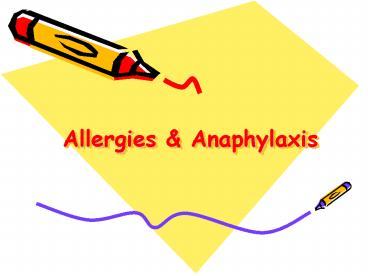Allergies PowerPoint PPT Presentation
1 / 24
Title: Allergies
1
Allergies Anaphylaxis
2
What is an Allergy?
- Allergies occur when the immune system becomes
- unusually sensitive and overreacts to common
- substances that are normally harmless. Examples
are - Foods eggs, milk, peanuts/nuts, shellfish,
fish, wheat, soy, sesame and some food additives - Stings from bees, wasps, hornets and some ants
- Medications penicillin, sulfa drugs
- Exercise
- Latex (gloves/medical devices)
3
What is Anaphylaxis?
- Occurs when a person is exposed to an allergen
causing a severe, life-threatening allergic
response - Reactions can occur within seconds of exposure to
an allergen, but can be delayed for 2-3 hours - Affects various organ systems including the skin,
respiratory, cardiovascular and gastrointestinal
4
Why is this life-threatening?
- Causes airway obstruction/lack of oxygen to the
brain - Increases risk of SHOCK, which leads to
widespread tissue damage, organ failure and
eventually death
5
Prevention Having a Plan
- Check the School Medical Alert List to
familiarize yourself with students in your
school/class who have medical conditions and
allergies - Note all students who require single dose
auto-injectors and where these are stored for
each student. Ensure auto-injectors are
immediately available - Review emergency care plans for individual
students - Recognize allergy sources and triggers
- Know when and how to administer the auto-injector
6
Common Symptoms
- Skin hives , swelling, itching, warmth,
redness, rash - Respiratory (breathing) wheezing, shortness of
breath, throat tightness, cough, hoarse voice,
chest pain/tightness, nasal congestion or hay
fever-like symptoms (runny itchy nose and watery
eyes, sneezing), trouble swallowing
7
Common Symptoms
- Gastrointestinal (stomach) nausea, pain/cramps,
vomiting, diarrhea - Cardiovascular (heart) pale/blue colour, weak
pulse, passing out, dizzy/lightheaded, shock - Other anxiety, feeling of impending doom,
headache, uterine cramps in females
8
Before giving Epinephrine
After giving Epinephrine
Mild to Moderate Allergic Reaction Hives and
Swelling of face
www.natureshomoeo.com.au/image/student.JPG
9
Moderate Allergic Reaction Swollen lips/face
and hives present
www.sovereign-publications.com/.../ANAPHYL.jpg
10
health.yahoo.com/media/healthwise/h9991075.jpg
11
Anaphylaxis What should I do?
- Administer single dose auto-injector
- Call 911
- Notify Parent/Guardian
- Administer second single dose auto-injector in
10 to 15 minutes, or sooner IF symptoms do
not improve or if symptoms recur - Have ambulance transport student to hospital
- Epinephrine is the only way to reverse the
effects of anaphylaxis therefore needs to be
given ASAP - Remember, the Epinephrine may only last for 15
minutes, calling 911 is very
important
12
Anaphylaxis What should I do?
- Symptoms of anaphylaxis can be as simple as
tingling of the lips or as severe as cardiac
arrest. When in doubt, administer epinephrine - If a person says they are having a reaction it is
important to believe them, and immediately
administer epinephrine regardless of the symptoms
present
13
What is a Single Dose, Epinephrine Auto-injector?
- A single dose auto-injector is an easy way to
give epinephrine/adrenaline to someone having an
allergic reaction - E.g. EpiPen, Twinject
14
What is in an EpiPen?
Single dose of epinephrine
15
Using the EpiPen Auto-Injector
- Remove the device from the plastic protective
container - Remove the GREY cap from device
- Press BLACK tip to thigh until a loud click is
heard - Hold in place for 10-15 seconds
16
Using the EpiPen Auto-Injector
- Remove the pen from the thigh
- The needle can now be seen, place auto-injector
back in protective case - Apply pressure to injection site with a tissue or
bandage if there is bleeding - Follow Standard Precautions for your safety (e.g.
wear gloves, be careful when handling exposed
auto-injector needle)
17
What is Twinject?
- Contains two doses of epinephrine in a single
device - First dose of epinephrine is administered by
auto-injection, just like the EpiPen.
18
Using the Twinject Auto-Injector
- Pull off GREEN end cap labeled 1
- Pull off GREEN end cap labeled 2
- Press RED cap into outer thigh until unit
activates
19
Using the Twinject Auto-Injector
- Hold Twinject in place for 10 seconds
- Apply pressure to injection site with a tissue or
bandage if there is bleeding - Follow Standard Precautions for your safety (e.g.
wear gloves, be careful when handling exposed
auto-injector needle) - Remember, staff are not recommended to give
dose two (manual IM injection of epinephrine)
20
What to do after giving a single dose
auto-injector?
- Have student lie still on his or her back with
feet higher than the head - Loosen tight clothing and cover student with
blanket - If there is vomiting, turn student on side to
prevent choking - Dont give anything to drink
- Send auto-injector with student to hospital
21
ConclusionFollow the three As
- Awareness
- Know the triggers
- Know the emergency plan and how to administer
epinephrine via the single dose auto-injector - Avoidance
- Avoid contact with allergens, make classrooms
safe - Action
- Give single dose auto-injector and call 911.
- Dont delay!
22
Resources
- For more information contact your Public Health
Nurse - www.aaia.ca (Allergy/Asthma Information Assoc.)
- www.anaphylaxis.org (Anaphylaxis Canada)
- www.epipen.ca (EpiPen)
- www.twinject.ca (Twinject)
- www.medicalert.ca
- www.bchealthguide.org/healthfiles
23
References
- AAIA Anaphylaxis Reference Kit (2007) by the
Allergy and Asthma Information Association,
Health Canada - Anaphylaxis in Schools Other Settings (2005) by
the Canadian Society of Allergy and Clinical
Immunology.
24
Any Questions?

